-
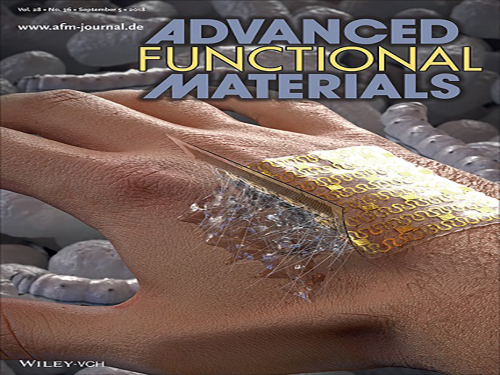 Silk Adhesive Paves the Way for Epidermal Electronics
(from left: Dr. Ji-Won Seo, Professor Hyunjoo Jenny Lee and PhD candidate, Hyojung Kim)
Producing effective epidermal electronics requires a strong, biocompatible interface between a biological surface and a sensor. Here, a KAIST team employed a calcium-modified silk fibroin as a biocompatible and strong adhesive. This technology led to the development of epidermal electronics with strong adhesion for patients who need drug injections and physiological monitoring over a long time.
Recently, biocompatible silk fibroins has been increasingly used for flexible substrates and water-soluble sacrificial layers because they allow structural modifications and are biodegradable. From previous studies, the team discovered the adhesive properties of silk fibroin via metal chelate bonding and the water-capturing of Ca ions.
Professor Hyunjoo Jenny Lee from the School of Electrical Engineering and her team explored ways to develop reusable, water-degradable, biocompatible and conductive epidermal electronics that can be attached to the human skin for long-term use. To overcome the limitations of conventional silk fibroin, the team introduced Ca ions to modify silk fibroin into a strong and biocompatible adhesive.
Calcium ions adopted in silk fibroins serve to capture water and enhance the cohesion force through metal chelation. Therefore, this endows viscoelasticity to previously a firm silk fibroin. This modified silk fibroin exhibits strong viscoelasticity and strong adhesiveness when physically attached to the human skin and various polymer substrates. Their developed silk adhesive is reusable, water-degradable, biocompatible, and conductive.
To test the effectiveness, the team employed the silk adhesive to fabricate an epidermal capacitive touch sensor that can be attached to the human skin. They verified the reusability of the sensor by performing attachment and detachment tests. They also confirmed that the physical adhesion of the Ca-modified silk facilitates its reusability and possesses high peel strength.
Furthermore, they tested the stretchability of the silk adhesive on bladder tissue. Although it is not an epidermal skin, bladder tissue is highly stretchable. Hence, it is a perfect target to measure the resistance-strain characteristic of the silk adhesive. When the bladder tissue was stretched, the resistive strain epidermal sensor corresponded to the tensile strain.
Showing high biocompatibility, the silk adhesive is suitable for interfacing with the human skin for a long period of time. Therefore, it can also be applied to a drug delivery epidermal system as well as an electrocardiogram (ECG) epidermal sensor.
Professor Lee said, “We are opening up a novel use for silk by developing reusable and biodegradable silk adhesive using biocompatible silk fibroin. This technology will contribute to the development of next-generation epidermal electronics as well as drug delivery systems.
This research, led by Dr. Ji-Won Seo and a PhD candidate, Hyojung Kim, was published in Advanced Functional Materials on September 5, 2018.
Figure 1. Schematic and photograph of a hydrogel patch adhered on the human skin through the silk adhesive
Figure 2. Cover page of Advanced Functional Materials
2018.11.21 View 6655
Silk Adhesive Paves the Way for Epidermal Electronics
(from left: Dr. Ji-Won Seo, Professor Hyunjoo Jenny Lee and PhD candidate, Hyojung Kim)
Producing effective epidermal electronics requires a strong, biocompatible interface between a biological surface and a sensor. Here, a KAIST team employed a calcium-modified silk fibroin as a biocompatible and strong adhesive. This technology led to the development of epidermal electronics with strong adhesion for patients who need drug injections and physiological monitoring over a long time.
Recently, biocompatible silk fibroins has been increasingly used for flexible substrates and water-soluble sacrificial layers because they allow structural modifications and are biodegradable. From previous studies, the team discovered the adhesive properties of silk fibroin via metal chelate bonding and the water-capturing of Ca ions.
Professor Hyunjoo Jenny Lee from the School of Electrical Engineering and her team explored ways to develop reusable, water-degradable, biocompatible and conductive epidermal electronics that can be attached to the human skin for long-term use. To overcome the limitations of conventional silk fibroin, the team introduced Ca ions to modify silk fibroin into a strong and biocompatible adhesive.
Calcium ions adopted in silk fibroins serve to capture water and enhance the cohesion force through metal chelation. Therefore, this endows viscoelasticity to previously a firm silk fibroin. This modified silk fibroin exhibits strong viscoelasticity and strong adhesiveness when physically attached to the human skin and various polymer substrates. Their developed silk adhesive is reusable, water-degradable, biocompatible, and conductive.
To test the effectiveness, the team employed the silk adhesive to fabricate an epidermal capacitive touch sensor that can be attached to the human skin. They verified the reusability of the sensor by performing attachment and detachment tests. They also confirmed that the physical adhesion of the Ca-modified silk facilitates its reusability and possesses high peel strength.
Furthermore, they tested the stretchability of the silk adhesive on bladder tissue. Although it is not an epidermal skin, bladder tissue is highly stretchable. Hence, it is a perfect target to measure the resistance-strain characteristic of the silk adhesive. When the bladder tissue was stretched, the resistive strain epidermal sensor corresponded to the tensile strain.
Showing high biocompatibility, the silk adhesive is suitable for interfacing with the human skin for a long period of time. Therefore, it can also be applied to a drug delivery epidermal system as well as an electrocardiogram (ECG) epidermal sensor.
Professor Lee said, “We are opening up a novel use for silk by developing reusable and biodegradable silk adhesive using biocompatible silk fibroin. This technology will contribute to the development of next-generation epidermal electronics as well as drug delivery systems.
This research, led by Dr. Ji-Won Seo and a PhD candidate, Hyojung Kim, was published in Advanced Functional Materials on September 5, 2018.
Figure 1. Schematic and photograph of a hydrogel patch adhered on the human skin through the silk adhesive
Figure 2. Cover page of Advanced Functional Materials
2018.11.21 View 6655 -
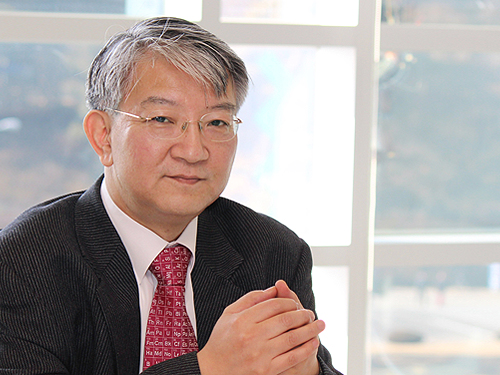 Distinguished Professor Lee Re-Appointed As Co-Chair of the Global Future Council on Biotechnology
(Distinguished Professor Sang Yup Lee)
Distinguished Professor Sang Yup Lee from the Department of Chemical and Biomolecular Engineering was re-appointed as the co-chair of the Global Future Council on Biotechnology at the World Economic Forum during the annual GFC meeting in Dubai, UAE last week. Elizabeth O’Day, founder and CEO of Olaris Therapeutics, will co-chair the council with him for two years.
Professor Lee served as the inaugural co-chair of the council for two years from 2016 with Professor Feng Zhang from the Broad Institute of MIT and Harvard.
The World Economic Forum’s Global Future Councils on Biotechnology is comprised of 14 members and aims to identify policy opportunities to help accelerate new biotechnological discoveries and applications while guiding dialogue with consumers about their implications.
Professor Lee, who has made significant research breakthroughs in the field of systems metabolic engineering, received the George Washington Carver Award, the PV Danckwerts Memorial Lecture Award, and the Eni Award this year.
2018.11.19 View 3959
Distinguished Professor Lee Re-Appointed As Co-Chair of the Global Future Council on Biotechnology
(Distinguished Professor Sang Yup Lee)
Distinguished Professor Sang Yup Lee from the Department of Chemical and Biomolecular Engineering was re-appointed as the co-chair of the Global Future Council on Biotechnology at the World Economic Forum during the annual GFC meeting in Dubai, UAE last week. Elizabeth O’Day, founder and CEO of Olaris Therapeutics, will co-chair the council with him for two years.
Professor Lee served as the inaugural co-chair of the council for two years from 2016 with Professor Feng Zhang from the Broad Institute of MIT and Harvard.
The World Economic Forum’s Global Future Councils on Biotechnology is comprised of 14 members and aims to identify policy opportunities to help accelerate new biotechnological discoveries and applications while guiding dialogue with consumers about their implications.
Professor Lee, who has made significant research breakthroughs in the field of systems metabolic engineering, received the George Washington Carver Award, the PV Danckwerts Memorial Lecture Award, and the Eni Award this year.
2018.11.19 View 3959 -
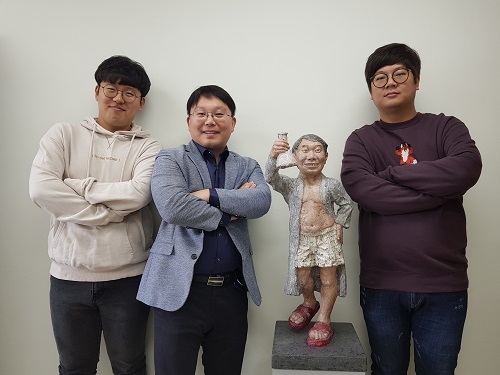 Novel Strategies to Transform a Commercially Available Iboga Alkaloid to Post-Iboga Alkaloids
(PhD candidate HyeonggeunLim, Professor Sunkyu Han, PhD candidate Sikwang Seong)
KAIST chemists have synthesized seven different iboga and post-iboga natural products from commercially available catharanthine by mirroring nature’s biosynthetic post-modification of the iboga skeleton. They devised a novel strategy to biosynthesize the natural products via a series of selective and efficient oxidation and rearrangement reactions. This will serve as a stepping stone for developing therapeutic medications against cancer and narcotics addiction.
The research team, led by Professor Sunkyu Han, conceptualized and coined the term “Post-Iboga” alkaloids to describe the natural products that are biosynthetically derived from iboga-type alkaloids, which are composed of rearranged indole and/or isoquinuclidine backbones.
Iboga alkaloids have attracted significant attention from the scientific community due to their intriguing polycyclic structures and potential therapeutic uses against drug addictions. Nature has evolved to add architectural repertoires to this family of secondary metabolites by diversifying the iboga frameworks.
Notable examples are the FDA-approved anticancer drugs vinblastine and vincristine, both derived by the oxidative dimerization of catharanthine and vindoline subunits. Admittedly, synthetic foci toward the biosynthetic iboga-derivatives have historically been on these aforementioned dimeric natural products.
Recent natural product isolation studies on Tabernaemontana corymbosa and Ervatamia officinalis species have resulted in discoveries of various secondary metabolites that are biosynthetically derived from iboga alkaloids. These recent outbursts of iboga-derived natural product isolation reports have kindled interests toward these family of natural products.
The research team utilized (+)-catharanthine, the starting material for the industrial production of the anticancer drug Navelbine®. Well-orchestrated oxidations at the C19 position and the indole moiety of the catharanthine derivative, followed by differential rearrangements under acidic conditions, provided synthetic samples of voatinggine and tabertinggine respectively.
On the other hand, opportune oxidations at the C19 position and the alpha position of the tertiary amine moiety of the catharantine derivative, followed by a transhemiaminalization, produced the first synthetic sample of chippiine/dippinine-type natural product, dippinine B.
It is important to note that the chippiine and dippinine-type alkaloids have been targeted among synthetic chemists for over 30 years but had not succumbed to synthesis prior to this report.
Professor Han believes that their study will serve as a blueprint for further explorations of the synthesis, biosynthesis, and pharmacology of this emerging family of natural products. This study was published in Chem on November 15, 2018 (DOI: 10.1016/j.chempr.2018.10.009).
2018.11.16 View 5816
Novel Strategies to Transform a Commercially Available Iboga Alkaloid to Post-Iboga Alkaloids
(PhD candidate HyeonggeunLim, Professor Sunkyu Han, PhD candidate Sikwang Seong)
KAIST chemists have synthesized seven different iboga and post-iboga natural products from commercially available catharanthine by mirroring nature’s biosynthetic post-modification of the iboga skeleton. They devised a novel strategy to biosynthesize the natural products via a series of selective and efficient oxidation and rearrangement reactions. This will serve as a stepping stone for developing therapeutic medications against cancer and narcotics addiction.
The research team, led by Professor Sunkyu Han, conceptualized and coined the term “Post-Iboga” alkaloids to describe the natural products that are biosynthetically derived from iboga-type alkaloids, which are composed of rearranged indole and/or isoquinuclidine backbones.
Iboga alkaloids have attracted significant attention from the scientific community due to their intriguing polycyclic structures and potential therapeutic uses against drug addictions. Nature has evolved to add architectural repertoires to this family of secondary metabolites by diversifying the iboga frameworks.
Notable examples are the FDA-approved anticancer drugs vinblastine and vincristine, both derived by the oxidative dimerization of catharanthine and vindoline subunits. Admittedly, synthetic foci toward the biosynthetic iboga-derivatives have historically been on these aforementioned dimeric natural products.
Recent natural product isolation studies on Tabernaemontana corymbosa and Ervatamia officinalis species have resulted in discoveries of various secondary metabolites that are biosynthetically derived from iboga alkaloids. These recent outbursts of iboga-derived natural product isolation reports have kindled interests toward these family of natural products.
The research team utilized (+)-catharanthine, the starting material for the industrial production of the anticancer drug Navelbine®. Well-orchestrated oxidations at the C19 position and the indole moiety of the catharanthine derivative, followed by differential rearrangements under acidic conditions, provided synthetic samples of voatinggine and tabertinggine respectively.
On the other hand, opportune oxidations at the C19 position and the alpha position of the tertiary amine moiety of the catharantine derivative, followed by a transhemiaminalization, produced the first synthetic sample of chippiine/dippinine-type natural product, dippinine B.
It is important to note that the chippiine and dippinine-type alkaloids have been targeted among synthetic chemists for over 30 years but had not succumbed to synthesis prior to this report.
Professor Han believes that their study will serve as a blueprint for further explorations of the synthesis, biosynthesis, and pharmacology of this emerging family of natural products. This study was published in Chem on November 15, 2018 (DOI: 10.1016/j.chempr.2018.10.009).
2018.11.16 View 5816 -
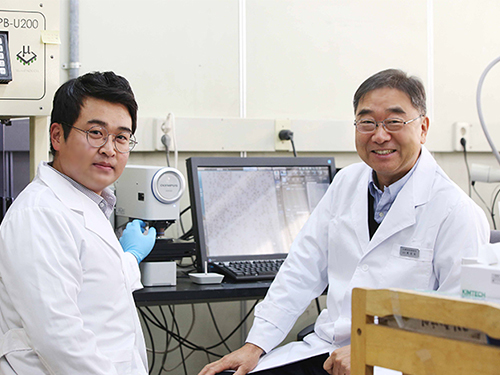 New Anisotropic Conductive Film for Ultra-Fine Pitch Assembly Applications
(Professor Paik(right) and PhD Candidate Yoon)
Higher resolution display electronic devices increasingly needs ultra-fine pitch assemblies. On that account, display driver interconnection technology has become a major challenge for upscaling display electronics.
Researchers have moved to one step closer to realizing ultra-fine resolution for displays with a novel thermoplastic anchoring polymer layer structure. This new structure can significantly improve the ultra-fine pitch interconnection by effectively suppressing the movement of conductive particles. This film is expected to be applied to various mobile devices, large-sized OLED panels, and VR, among others.
A research team under Professor Kyung-Wook Paik in the Department of Materials developed an anchoring polymer layer structure that can effectively suppress the movement of conductive particles during the bonding process of the anisotropic conductive films (ACFs). The new structure will significantly improve the conductive particle capture rate, addressing electrical short problems in the ultra-fine pitch assembly process.
During the ultra-fine pitch bonding process, the conductive particles of conventional ACFs agglomerate between bumps and cause electrical short circuits. To overcome the electrical shortage problem caused by the free movement of conductive particles, higher tensile strength anchoring polymer layers incorporated with conductive particles were introduced into the ACFs to effectively prevent conductive particle movement.
The team used nylon to produce a single layer film with well-distributed and incorporated conductive particles. The higher tensile strength of nylon completely suppressed the movement of conductive particles, raising the capture rate of conductive particles from 33% of the conventional ACFs to 90%. The nylon films showed no short circuit problem during the Chip on Glass assembly. Even more, they obtained excellent electrical conductivity, high reliability, and low cost ACFs during the ultra-fine pitch applications.
Professor Paik believes this new type of ACFs can further be applied not only to VR, 4K and 8K UHD display products, but also to large-size OLED panels and mobile devices.
His team completed a prototype of the film supported by the ‘H&S High-Tech,’ a domestic company and the ‘Innopolis Foundation.’ The study, whose first author is PhD candidate Dal-Jin Yoon, is described in the October issue of IEEE TCPMT.
Figure 1: Schematic process of APL structure fabrication.
Figure 2: Proto-type production of APL ACFs.
2018.11.13 View 6520
New Anisotropic Conductive Film for Ultra-Fine Pitch Assembly Applications
(Professor Paik(right) and PhD Candidate Yoon)
Higher resolution display electronic devices increasingly needs ultra-fine pitch assemblies. On that account, display driver interconnection technology has become a major challenge for upscaling display electronics.
Researchers have moved to one step closer to realizing ultra-fine resolution for displays with a novel thermoplastic anchoring polymer layer structure. This new structure can significantly improve the ultra-fine pitch interconnection by effectively suppressing the movement of conductive particles. This film is expected to be applied to various mobile devices, large-sized OLED panels, and VR, among others.
A research team under Professor Kyung-Wook Paik in the Department of Materials developed an anchoring polymer layer structure that can effectively suppress the movement of conductive particles during the bonding process of the anisotropic conductive films (ACFs). The new structure will significantly improve the conductive particle capture rate, addressing electrical short problems in the ultra-fine pitch assembly process.
During the ultra-fine pitch bonding process, the conductive particles of conventional ACFs agglomerate between bumps and cause electrical short circuits. To overcome the electrical shortage problem caused by the free movement of conductive particles, higher tensile strength anchoring polymer layers incorporated with conductive particles were introduced into the ACFs to effectively prevent conductive particle movement.
The team used nylon to produce a single layer film with well-distributed and incorporated conductive particles. The higher tensile strength of nylon completely suppressed the movement of conductive particles, raising the capture rate of conductive particles from 33% of the conventional ACFs to 90%. The nylon films showed no short circuit problem during the Chip on Glass assembly. Even more, they obtained excellent electrical conductivity, high reliability, and low cost ACFs during the ultra-fine pitch applications.
Professor Paik believes this new type of ACFs can further be applied not only to VR, 4K and 8K UHD display products, but also to large-size OLED panels and mobile devices.
His team completed a prototype of the film supported by the ‘H&S High-Tech,’ a domestic company and the ‘Innopolis Foundation.’ The study, whose first author is PhD candidate Dal-Jin Yoon, is described in the October issue of IEEE TCPMT.
Figure 1: Schematic process of APL structure fabrication.
Figure 2: Proto-type production of APL ACFs.
2018.11.13 View 6520 -
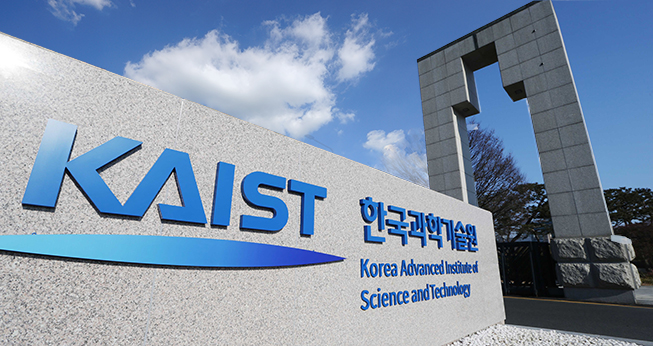 OUIC Presents the Six Most Promising Techs Transferrable to Local SMEs
KAIST will showcase the six most promising technologies for small and medium enterprises (SMEs) on November 14 in the Academic Cultural Complex. To strengthen the competitive edge of local SMEs in Daejeon, the Office of University-Industry made a survey of their technological needs and came up with the six most promising technologies. Developers will introduce their technologies during the session.Besides the introduction of the promising technologies, the session will also provide a program named University to Business (U2B) to match up technologies according to the SMEs’ needs. SMEs who wish to engage in technology transfers can receive counseling and other support programs during the session.First, Professor Seok-Hyung Bae from the Department of Industrial Design will present a technology for controlling cooperation robots. Professor Bae inserted flexible materials between the controllers to allow robots to use both hands stably and operate more accurately and swiftly. It can be applied to automatic robots, industrial robots, and service robots.Professor Hyun Myung from the Department of Civil & Environmental Engineering will demonstrate a robot navigation system in a dynamic indoor and outdoor environment, which can be applied to robotics in logistics, smart factories, and autonomous vehicles. Providing robust simultaneous localization and mapping systems, this technology shows high-performing navigation with low-cost sensors.Meanwhile, Professor Siyoung Choi from the Department of Chemical and Biomolecular Engineering will introduce a technology for forming stable adhesive emulsions. An emulsion is a stable mixture of water and oil. Conventionally, a small amount of surfactant is added to stabilize an emulsion. Here, Professor Choi developed a stable emulsion system without using any chemical substances. This technology can be applied to various fields, including the cosmetics, pharmaceutical, semiconductor, and painting industries. The session will also present smart IoTs platform technology developed by Professor Jinhong Yang from the KAIST Institute for IT Convergence. His technology minimizes errors occurring when multiple IoT devices are connected simultaneously. Professor Yong Keun Park from the Department of Physics will introduce a technology for measuring glycated hemoglobin by using the optical properties of red blood cells. This technology can be applied to make low-cost, small-sized measuring equipment. It can also be used for vitro diagnoses including diabetes, cardiovascular disorders, tumors, kidney disease, and infectious diseases. Professor Yong Man Ro from the School of Electrical Engineering will show technology for biometric access control. Conventional technologies for face recognition fall behind other biometrics. Professor Ro and his team developed a facial dynamics interpreting network which allows very accurate facial recognition by interpreting the relationships between facial local dynamics and estimating facial traits. This technology can be applied to security and communication in finance, computers, and information system.KAIST President Sung-Chul Shin said, “KAIST will continue to support SMEs to have stronger competitiveness in the market. Through technology transfer, we will drive innovation in technological commercialization where a university’s research and development creates economic value.”
2018.11.13 View 9365
OUIC Presents the Six Most Promising Techs Transferrable to Local SMEs
KAIST will showcase the six most promising technologies for small and medium enterprises (SMEs) on November 14 in the Academic Cultural Complex. To strengthen the competitive edge of local SMEs in Daejeon, the Office of University-Industry made a survey of their technological needs and came up with the six most promising technologies. Developers will introduce their technologies during the session.Besides the introduction of the promising technologies, the session will also provide a program named University to Business (U2B) to match up technologies according to the SMEs’ needs. SMEs who wish to engage in technology transfers can receive counseling and other support programs during the session.First, Professor Seok-Hyung Bae from the Department of Industrial Design will present a technology for controlling cooperation robots. Professor Bae inserted flexible materials between the controllers to allow robots to use both hands stably and operate more accurately and swiftly. It can be applied to automatic robots, industrial robots, and service robots.Professor Hyun Myung from the Department of Civil & Environmental Engineering will demonstrate a robot navigation system in a dynamic indoor and outdoor environment, which can be applied to robotics in logistics, smart factories, and autonomous vehicles. Providing robust simultaneous localization and mapping systems, this technology shows high-performing navigation with low-cost sensors.Meanwhile, Professor Siyoung Choi from the Department of Chemical and Biomolecular Engineering will introduce a technology for forming stable adhesive emulsions. An emulsion is a stable mixture of water and oil. Conventionally, a small amount of surfactant is added to stabilize an emulsion. Here, Professor Choi developed a stable emulsion system without using any chemical substances. This technology can be applied to various fields, including the cosmetics, pharmaceutical, semiconductor, and painting industries. The session will also present smart IoTs platform technology developed by Professor Jinhong Yang from the KAIST Institute for IT Convergence. His technology minimizes errors occurring when multiple IoT devices are connected simultaneously. Professor Yong Keun Park from the Department of Physics will introduce a technology for measuring glycated hemoglobin by using the optical properties of red blood cells. This technology can be applied to make low-cost, small-sized measuring equipment. It can also be used for vitro diagnoses including diabetes, cardiovascular disorders, tumors, kidney disease, and infectious diseases. Professor Yong Man Ro from the School of Electrical Engineering will show technology for biometric access control. Conventional technologies for face recognition fall behind other biometrics. Professor Ro and his team developed a facial dynamics interpreting network which allows very accurate facial recognition by interpreting the relationships between facial local dynamics and estimating facial traits. This technology can be applied to security and communication in finance, computers, and information system.KAIST President Sung-Chul Shin said, “KAIST will continue to support SMEs to have stronger competitiveness in the market. Through technology transfer, we will drive innovation in technological commercialization where a university’s research and development creates economic value.”
2018.11.13 View 9365 -
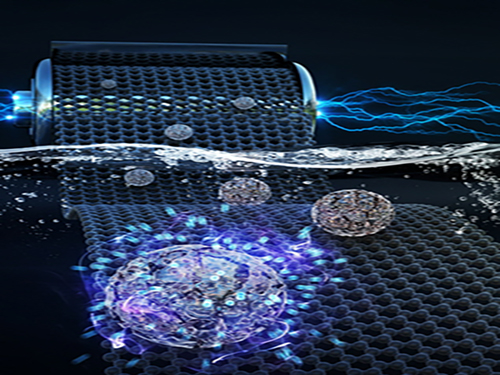 Faster and More Powerful Aqueous Hybrid Capacitor
(Professor Jeung Ku Kang from the Graduate School of EEWS)
A KAIST research team made it one step closer to realizing safe energy storage with high energy density, high power density, and a longer cycle life. This hybrid storage alternative shows power density 100 times faster than conventional batteries, allowing it to be charged within a few seconds. Hence, it is suitable for small portable electronic devices.
Conventional electrochemical energy storage systems, including lithium-ion batteries (LIBs), have a high voltage range and energy density, but are subject to safety issues raised by flammable organic electrolytes, which are used to ensure the beneficial properties. Additionally, they suffer from slow electrochemical reaction rates, which lead to a poor charging rate and low power density with a capacity that fades quickly, resulting in a short cycle life.
On the other hand, capacitors based on aqueous electrolytes are receiving a great deal of attention because they are considered to be safe and environmentally friendly alternatives. However, aqueous electrolytes lag behind energy storage systems based on organic electrolytes in terms of energy density due to their limited voltage range and low capacitance.
Hence, developing aqueous energy storage with high energy density and a long cycle life in addition to the high power density that enables fast charging is the most challenging task for advancing next-generation electrochemical energy storage devices.
Here, Professor Jeung Ku Kang from the Graduate School of Energy, Environment, Water and Sustainability and his team developed an aqueous hybrid capacitor (AHC) that boasts high energy density, high power, and excellent cycle stability by synthesizing two types of porous metal oxide nanoclusters on graphene to create positive and negative electrodes for AHCs.
The porous metal oxide nanoparticles are composed of nanoclusters as small as two to three nanometers and have mesopores that are smaller than five nanometers. In these porous structures, ions can be rapidly transferred to the material surfaces and a large number of ions can be stored inside the metal oxide particles very quickly due to their small particle size and large surface area.
The team applied porous manganese oxide on graphene for positive electrodes and porous iron oxide on graphene for negative electrodes to design an aqueous hybrid capacitor that can operate at an extended voltage range of 2V.
Professor Kang said, “This newly developed AHC with high capacity and power density driven from porous metal oxide electrodes will contribute to commercializing a new type of energy storage system. This technology allows ultra-fast charging within several seconds, making it suitable as a power source for mobile devices or electric vehicles where solar energy is directly stored as electricity.”
This research, co-led by Professor Hyung Mo Jeong from Kangwon National University, was published in Advanced Functional Materials on August 15, 2018.
Figure 1. Image that shows properties of porous metal oxide nanoparticles formed on graphene in the aqueous hybrid capacitor
2018.11.09 View 7770
Faster and More Powerful Aqueous Hybrid Capacitor
(Professor Jeung Ku Kang from the Graduate School of EEWS)
A KAIST research team made it one step closer to realizing safe energy storage with high energy density, high power density, and a longer cycle life. This hybrid storage alternative shows power density 100 times faster than conventional batteries, allowing it to be charged within a few seconds. Hence, it is suitable for small portable electronic devices.
Conventional electrochemical energy storage systems, including lithium-ion batteries (LIBs), have a high voltage range and energy density, but are subject to safety issues raised by flammable organic electrolytes, which are used to ensure the beneficial properties. Additionally, they suffer from slow electrochemical reaction rates, which lead to a poor charging rate and low power density with a capacity that fades quickly, resulting in a short cycle life.
On the other hand, capacitors based on aqueous electrolytes are receiving a great deal of attention because they are considered to be safe and environmentally friendly alternatives. However, aqueous electrolytes lag behind energy storage systems based on organic electrolytes in terms of energy density due to their limited voltage range and low capacitance.
Hence, developing aqueous energy storage with high energy density and a long cycle life in addition to the high power density that enables fast charging is the most challenging task for advancing next-generation electrochemical energy storage devices.
Here, Professor Jeung Ku Kang from the Graduate School of Energy, Environment, Water and Sustainability and his team developed an aqueous hybrid capacitor (AHC) that boasts high energy density, high power, and excellent cycle stability by synthesizing two types of porous metal oxide nanoclusters on graphene to create positive and negative electrodes for AHCs.
The porous metal oxide nanoparticles are composed of nanoclusters as small as two to three nanometers and have mesopores that are smaller than five nanometers. In these porous structures, ions can be rapidly transferred to the material surfaces and a large number of ions can be stored inside the metal oxide particles very quickly due to their small particle size and large surface area.
The team applied porous manganese oxide on graphene for positive electrodes and porous iron oxide on graphene for negative electrodes to design an aqueous hybrid capacitor that can operate at an extended voltage range of 2V.
Professor Kang said, “This newly developed AHC with high capacity and power density driven from porous metal oxide electrodes will contribute to commercializing a new type of energy storage system. This technology allows ultra-fast charging within several seconds, making it suitable as a power source for mobile devices or electric vehicles where solar energy is directly stored as electricity.”
This research, co-led by Professor Hyung Mo Jeong from Kangwon National University, was published in Advanced Functional Materials on August 15, 2018.
Figure 1. Image that shows properties of porous metal oxide nanoparticles formed on graphene in the aqueous hybrid capacitor
2018.11.09 View 7770 -
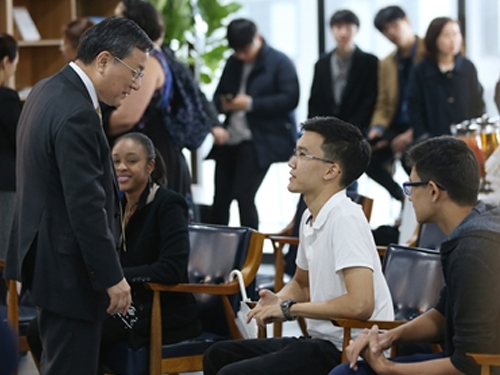 Global Lounge Opens for Language and Cultural Exchange
KAIST celebrated the opening of its new Global Lounge on November 8. KAIST’s president, administrative executives, representatives of Korean and international student associations, and many other students attended the ceremony.
The Global Lounge, located on the fourth floor of the Academic Cultural Complex, was opened for students to share language and culture in a warm and pleasant environment. The Global Lounge will serve as a comfortable and open space. Students around the world can build networks by interacting with one another and freely sharing their ideas.
The lounge offers travel guidebooks and magazines for those who wish to learn more about countries around the world. It also boasts a room for seminars and a tearoom. The seminar room will be used for multipurpose space; while activities such as meditation, tea classes, and etiquette lessons will take place in the tearoom. One of the major highlights of the global lounge is that it exhibits cultural artifacts donated by embassies in Korea.
At the opening ceremony, President Sung-Chul Shin expressed the importance of communication and interaction among students by saying, “You can better embrace challenges and come up with creative ideas when you are interacting with others. I hope this Global Lounge serves as a multi-functional space for raising cultural awareness.”
2018.11.08 View 2809
Global Lounge Opens for Language and Cultural Exchange
KAIST celebrated the opening of its new Global Lounge on November 8. KAIST’s president, administrative executives, representatives of Korean and international student associations, and many other students attended the ceremony.
The Global Lounge, located on the fourth floor of the Academic Cultural Complex, was opened for students to share language and culture in a warm and pleasant environment. The Global Lounge will serve as a comfortable and open space. Students around the world can build networks by interacting with one another and freely sharing their ideas.
The lounge offers travel guidebooks and magazines for those who wish to learn more about countries around the world. It also boasts a room for seminars and a tearoom. The seminar room will be used for multipurpose space; while activities such as meditation, tea classes, and etiquette lessons will take place in the tearoom. One of the major highlights of the global lounge is that it exhibits cultural artifacts donated by embassies in Korea.
At the opening ceremony, President Sung-Chul Shin expressed the importance of communication and interaction among students by saying, “You can better embrace challenges and come up with creative ideas when you are interacting with others. I hope this Global Lounge serves as a multi-functional space for raising cultural awareness.”
2018.11.08 View 2809 -
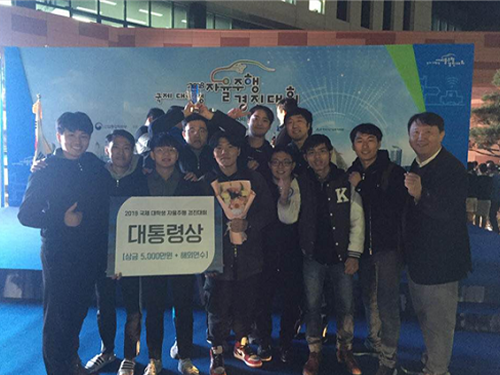 Team KAT Wins the Autonomous Car Challenge
(Team KAT receiving the Presidential Award)
A KAIST team won the 2018 International Autonomous Car Challenge for University Students held in Daegu on November 2.
Professor Seung-Hyun Kong from the ChoChunShik Graduate School of Green Transportation and his team participated in this contest with the team named KAT (KAIST Autonomous Technologies). The team received the Presidential Award with a fifty million won cash prize and an opportunity for a field trip abroad.
The competition was conducted on actual roads with Connected Autonomous Vehicles (CAV), which incorporate autonomous driving technologies and vehicle-to-everything (V2X) communication system.
In this contest, the autonomous vehicles were given a mission to pick up passengers or parcels. Through the V2X communication, the contest gave current location of the passengers or parcels, their destination, and service profitability according to distance and level of service difficulty.
The participating vehicles had to be equipped very accurate and robust navigation system since they had to drive on narrow roads as well as go through tunnels where GPS was not available. Moreover, they had to use camera-based recognition technology that was invulnerable to backlight as the contest was in the late afternoon.
The contest scored the mission in the following way: the vehicles get points if they pick up passengers and safely drop them off at their destination; on the other hand, points are deducted when they violate lanes or traffic lights. It will be a major black mark if a participant sitting in the driver’s seat needs to get involved in driving due to a technical issue.
Youngbo Shim of KAT said, “We believe that we got major points for technical superiority in autonomous driving and our algorithm for passenger selection.”
This contest, hosted by Ministry of Trade, Industry and Energy, was the first international competition for autonomous driving on actual roads. A total of nine teams participated in the final contest, four domestic teams and five teams allied with overseas universities such as Tsinghua University, Waseda University, and Nanyang Technological University.
Professor Kong said, “There is still a long way to go for fully autonomous vehicles that drive flexibly under congested traffic conditions. However, we will continue to our research in order to achieve high-quality autonomous driving technology.”
(Team KAT getting ready for the challenge)
2018.11.06 View 12077
Team KAT Wins the Autonomous Car Challenge
(Team KAT receiving the Presidential Award)
A KAIST team won the 2018 International Autonomous Car Challenge for University Students held in Daegu on November 2.
Professor Seung-Hyun Kong from the ChoChunShik Graduate School of Green Transportation and his team participated in this contest with the team named KAT (KAIST Autonomous Technologies). The team received the Presidential Award with a fifty million won cash prize and an opportunity for a field trip abroad.
The competition was conducted on actual roads with Connected Autonomous Vehicles (CAV), which incorporate autonomous driving technologies and vehicle-to-everything (V2X) communication system.
In this contest, the autonomous vehicles were given a mission to pick up passengers or parcels. Through the V2X communication, the contest gave current location of the passengers or parcels, their destination, and service profitability according to distance and level of service difficulty.
The participating vehicles had to be equipped very accurate and robust navigation system since they had to drive on narrow roads as well as go through tunnels where GPS was not available. Moreover, they had to use camera-based recognition technology that was invulnerable to backlight as the contest was in the late afternoon.
The contest scored the mission in the following way: the vehicles get points if they pick up passengers and safely drop them off at their destination; on the other hand, points are deducted when they violate lanes or traffic lights. It will be a major black mark if a participant sitting in the driver’s seat needs to get involved in driving due to a technical issue.
Youngbo Shim of KAT said, “We believe that we got major points for technical superiority in autonomous driving and our algorithm for passenger selection.”
This contest, hosted by Ministry of Trade, Industry and Energy, was the first international competition for autonomous driving on actual roads. A total of nine teams participated in the final contest, four domestic teams and five teams allied with overseas universities such as Tsinghua University, Waseda University, and Nanyang Technological University.
Professor Kong said, “There is still a long way to go for fully autonomous vehicles that drive flexibly under congested traffic conditions. However, we will continue to our research in order to achieve high-quality autonomous driving technology.”
(Team KAT getting ready for the challenge)
2018.11.06 View 12077 -
 Controlling Crystal Size of Organic Semiconductors
A KAIST research team led by Professor Steve Park from the Department of Materials Science and Engineering
Recently, solution-processable organic semiconductors are being highlighted for their potential application in printed electronics, becoming a feasible technique to fabricate large-area flexible thin film at a low cost. The field-effect mobility of small-molecule organic semiconductors is dependent on the crystallinity, crystal orientation, and crystal size. A variety of solution-based coating techniques, such as ink-jet printing, dip-coating, and solution shearing have been developed to control the crystallinity and crystal orientation, but a method for developing techniques to increase the crystal size of organic semiconductors is still needed.
To overcome this issue, the research team developed an inorganic polymer micropillar-based solution shearing system to increase the crystal size of an organic semiconductor with pillar size. Using this technique, the crystallization process of organic semiconductors can be controlled precisely, and therefore large-area organic semiconductor thin film with controlled crystallinity can be fabricated.
A variety of solution-based coating techniques cannot control the fluid-flow of solutions appropriately, so the solvent evaporates randomly onto the substrate, which has difficulty in the fabrication of organic semiconductor thin film with a large crystal size.
The research team integrated inorganic polymer microstructures into the solution shearing blade to solve this issue. The inorganic polymer can easily be microstructured via conventional molding techniques, has high mechanical durability, and organic solvent resistance. Using the inorganic polymer-based microstructure blade, the research team controlled the size of small molecule organic semiconductors by tuning the shape and dimensions of the microstructure. The microstructures in the blade induce the sharp curvature regions in the meniscus line that formed between the shearing blade and the substrate, and therefore nucleation and crystal growth can be regulated. Hence, the research team fabricated organic semiconductor thin-film with large crystals, which increases the field-effect mobility.
The research team also demonstrated a solution shearing process on a curved surface by using a flexible inorganic polymer-based shearing blade, which expands the applicability of solution shearing.
Professor Park said, “Our new solution shearing system can control the crystallization process precisely during solvent evaporation.” He added, “This technique adds another key parameter that can be utilized to tune the property of thin films and opens up a wide variety of new applications.
The results of this work entitled “Inorganic Polymer Micropillar-Based Solution Shearing of Large-Area Organic Semiconductor Thin Films with Pillar-Size-Dependent Crystal Size” was published in the July 2018 issue of Advanced Materials as a cover article.
2018.10.30 View 6295
Controlling Crystal Size of Organic Semiconductors
A KAIST research team led by Professor Steve Park from the Department of Materials Science and Engineering
Recently, solution-processable organic semiconductors are being highlighted for their potential application in printed electronics, becoming a feasible technique to fabricate large-area flexible thin film at a low cost. The field-effect mobility of small-molecule organic semiconductors is dependent on the crystallinity, crystal orientation, and crystal size. A variety of solution-based coating techniques, such as ink-jet printing, dip-coating, and solution shearing have been developed to control the crystallinity and crystal orientation, but a method for developing techniques to increase the crystal size of organic semiconductors is still needed.
To overcome this issue, the research team developed an inorganic polymer micropillar-based solution shearing system to increase the crystal size of an organic semiconductor with pillar size. Using this technique, the crystallization process of organic semiconductors can be controlled precisely, and therefore large-area organic semiconductor thin film with controlled crystallinity can be fabricated.
A variety of solution-based coating techniques cannot control the fluid-flow of solutions appropriately, so the solvent evaporates randomly onto the substrate, which has difficulty in the fabrication of organic semiconductor thin film with a large crystal size.
The research team integrated inorganic polymer microstructures into the solution shearing blade to solve this issue. The inorganic polymer can easily be microstructured via conventional molding techniques, has high mechanical durability, and organic solvent resistance. Using the inorganic polymer-based microstructure blade, the research team controlled the size of small molecule organic semiconductors by tuning the shape and dimensions of the microstructure. The microstructures in the blade induce the sharp curvature regions in the meniscus line that formed between the shearing blade and the substrate, and therefore nucleation and crystal growth can be regulated. Hence, the research team fabricated organic semiconductor thin-film with large crystals, which increases the field-effect mobility.
The research team also demonstrated a solution shearing process on a curved surface by using a flexible inorganic polymer-based shearing blade, which expands the applicability of solution shearing.
Professor Park said, “Our new solution shearing system can control the crystallization process precisely during solvent evaporation.” He added, “This technique adds another key parameter that can be utilized to tune the property of thin films and opens up a wide variety of new applications.
The results of this work entitled “Inorganic Polymer Micropillar-Based Solution Shearing of Large-Area Organic Semiconductor Thin Films with Pillar-Size-Dependent Crystal Size” was published in the July 2018 issue of Advanced Materials as a cover article.
2018.10.30 View 6295 -
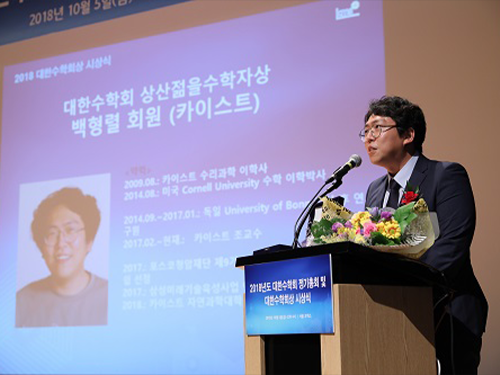 Professor Baik Awarded Sangsan Young Mathematician Prize
(Professor Hyungryul Baik)
Professor Hyungryul Baik from the Department of Mathematical Sciences was honored as the recipient of the 2018 Sangsan Prize for Young Mathematicians by the Korean Mathematical Society (KMS).
The Sangsan Prize recognizes young mathematicians who finished their degree within the previous five years and have begun an outstanding research career. Professor Baik was recognized for his studies in the fields of low-dimensional topology, geophysical mathematics, and geometric theory. In particular, his Ph.D. dissertation presented a new criterion that completely identifies the hyperbolic surface group, making an inference about the nature of the hyperbolic manifold group.
Recently, Professor Baik co-published a paper entitled Spaces of Invariant Circular Orders of Groups with Professor Eric Samperton at the University of California Santa Barbara in the renowned academic journal Groups, Geometry, and Dynamics in 2018.
Professor Baik earned his BS at KAIST and finished his MS and Ph.D. in mathematics in 2014 at Cornell University. He joined KAIST as a faculty member last year.
2018.10.30 View 6917
Professor Baik Awarded Sangsan Young Mathematician Prize
(Professor Hyungryul Baik)
Professor Hyungryul Baik from the Department of Mathematical Sciences was honored as the recipient of the 2018 Sangsan Prize for Young Mathematicians by the Korean Mathematical Society (KMS).
The Sangsan Prize recognizes young mathematicians who finished their degree within the previous five years and have begun an outstanding research career. Professor Baik was recognized for his studies in the fields of low-dimensional topology, geophysical mathematics, and geometric theory. In particular, his Ph.D. dissertation presented a new criterion that completely identifies the hyperbolic surface group, making an inference about the nature of the hyperbolic manifold group.
Recently, Professor Baik co-published a paper entitled Spaces of Invariant Circular Orders of Groups with Professor Eric Samperton at the University of California Santa Barbara in the renowned academic journal Groups, Geometry, and Dynamics in 2018.
Professor Baik earned his BS at KAIST and finished his MS and Ph.D. in mathematics in 2014 at Cornell University. He joined KAIST as a faculty member last year.
2018.10.30 View 6917 -
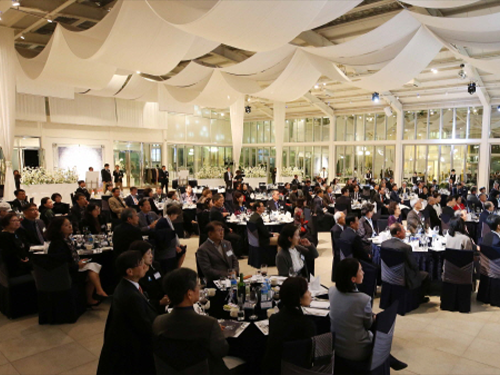 KAIST Thanks Supporters for Building KAIST of Today
KAIST hosted its first Fundraising Gala on October 26, 2018. It was organized to demonstrate deep gratitude to those who have made contributions to KAIST, making it possible to progress every year.
The KAIST Development Foundation (KDF) endeavored to make a meaningful and inclusive event by collecting archives that show the history of donations while sending invitatio ns to all the members of KAIST, including donors and potential donors as well as professors and student representatives.
Approximately 200 distinguished guests attended the gala, including major donors, Chairperson of KDF Soo Young Lee and Chairman Beang Ho Kim, Former Minister of Science Dr. Geun Mo Jung, Former Minister of Science and Technology Woo Sik Kim, and KAIST alumni including the first Korean astronaut So-Yeon Yi.
(Student cheer leading club, ELKA)
At the gala, KAIST shared its 47 years of funding and an expenditure summary with major performances achieved from the year it was founded. According to the summary, KAIST has received more than 323.1 billion won since 1971. The total number of donors was 12,906 while the number of contribution reached 77,710.
Among the total funding (323.1 billion won), corporate gifts made up 43.1% of the total and individual gifts stood at 39.1%, showing that KAIST has received and is receiving support evenly from companies and individuals.
Taking a close look at the major donors, there is an interesting fact about KAIST’s fundraising culture. There has been continuous support from individuals who did not have any personal or academic ties with KAIST before donating. However, they have made large gifts to KAIST so that the best students in the fields of science and technology can be fostered for the sake of national development. The major donors included Young Han Kim (1999), Moon Soul Chung (2001), Byiung Joon Park (2007), Keun Chul Ryu (2008), Beong Ho Kim (2009), Chun Shik Cho and E won Oh (2010), Soo Young Lee (2012), Tae-won Chey (2014), Jeong Ja Cho (2015), and Chang Kun Sohn (2017).
Especially, M. S. Chung, B. H. Kim, C. S. Cho and S. Y. Lee made additional mega-gifts to KAIST, showing continuous support for KAIST’s development.
Nevertheless, the KAIST fundraising culture could not be created with major donors only. Among the total number of donors (12,906), alumni showed the strong engagement standing at 40.4% while parents and students were at 26.1% and 12.7% respectively. The contribution numbers follow the order of alumni (34.8%), parents (20.3%), staff (20%), professors (13.3%), and students (5.7%). These statistics imply that individual’s constant donations play a significant part in the fundraising culture of KAIST.
Additionally, engagement continues to rise every year, and it reached 12,039 gifts in 2017, which increased 5.7 times over ten years.
(from left: Executive Director of KDF Young-gul Kim KAIST President Sung-Chul Shin)
These valuable gifts are the vital fuel for KAIST’s progress. As of 2018, KAIST has spent 205.8 billion won: 81.9 billion won for construction and facilities operation, 79.7 billion won for academics and research, 39 billion won for academic management, and 5.2 billion won for scholarships.
The construction and facilities operation fund aided the evolution of physical infrastructure. KAIST endowed the ChungMoonSoul Building for promoting convergence between information and biotechnology, the Yang Bun Soon Building for bio and brain engineering studies, and the Chunghi & Byiung Jun Park KI Building for multi and interdisciplinary research. Their generous gifts built the foundation for KAIST taking off towards becoming a global leading university.
Meanwhile, the academic and research funds provided opportunities to professors and students to carry out creative research and academic missions. The academic management fund helped open new departments (i.e. The Cho Chun Shik Graduate School of Green Transportation and the Moon Soul Graduate School of Future Strategy) and their programs, for which their names came from the major donors.
(The first Korean astronaut So-Yeon Yi)
At the gala, special events were held for two exclusive moments that contributed to promoting and making a better image for KAIST to the public. One was the 10th anniversary of the space exploration of the first Korean astronaut Dr. Yi. The other was the 20th anniversary of the TV drama series, called ‘KAIST’ which was aired from 1999 to 2000. The writer and main casting crew members joined the event. They said that it was their first time to gather in one place after the show last aired and this event would be memorable for them as well.
President Sung-Chul Shin said, “These gifts play the role of seed money that helps KAIST obtain competence in a global scenario. I hope people have more interest in supporting KAIST through this event.”
1 Total Amount of Gift
2 Total Donors
3 Expenditure Number of Contribution
4 Expenditure
2018.10.29 View 7935
KAIST Thanks Supporters for Building KAIST of Today
KAIST hosted its first Fundraising Gala on October 26, 2018. It was organized to demonstrate deep gratitude to those who have made contributions to KAIST, making it possible to progress every year.
The KAIST Development Foundation (KDF) endeavored to make a meaningful and inclusive event by collecting archives that show the history of donations while sending invitatio ns to all the members of KAIST, including donors and potential donors as well as professors and student representatives.
Approximately 200 distinguished guests attended the gala, including major donors, Chairperson of KDF Soo Young Lee and Chairman Beang Ho Kim, Former Minister of Science Dr. Geun Mo Jung, Former Minister of Science and Technology Woo Sik Kim, and KAIST alumni including the first Korean astronaut So-Yeon Yi.
(Student cheer leading club, ELKA)
At the gala, KAIST shared its 47 years of funding and an expenditure summary with major performances achieved from the year it was founded. According to the summary, KAIST has received more than 323.1 billion won since 1971. The total number of donors was 12,906 while the number of contribution reached 77,710.
Among the total funding (323.1 billion won), corporate gifts made up 43.1% of the total and individual gifts stood at 39.1%, showing that KAIST has received and is receiving support evenly from companies and individuals.
Taking a close look at the major donors, there is an interesting fact about KAIST’s fundraising culture. There has been continuous support from individuals who did not have any personal or academic ties with KAIST before donating. However, they have made large gifts to KAIST so that the best students in the fields of science and technology can be fostered for the sake of national development. The major donors included Young Han Kim (1999), Moon Soul Chung (2001), Byiung Joon Park (2007), Keun Chul Ryu (2008), Beong Ho Kim (2009), Chun Shik Cho and E won Oh (2010), Soo Young Lee (2012), Tae-won Chey (2014), Jeong Ja Cho (2015), and Chang Kun Sohn (2017).
Especially, M. S. Chung, B. H. Kim, C. S. Cho and S. Y. Lee made additional mega-gifts to KAIST, showing continuous support for KAIST’s development.
Nevertheless, the KAIST fundraising culture could not be created with major donors only. Among the total number of donors (12,906), alumni showed the strong engagement standing at 40.4% while parents and students were at 26.1% and 12.7% respectively. The contribution numbers follow the order of alumni (34.8%), parents (20.3%), staff (20%), professors (13.3%), and students (5.7%). These statistics imply that individual’s constant donations play a significant part in the fundraising culture of KAIST.
Additionally, engagement continues to rise every year, and it reached 12,039 gifts in 2017, which increased 5.7 times over ten years.
(from left: Executive Director of KDF Young-gul Kim KAIST President Sung-Chul Shin)
These valuable gifts are the vital fuel for KAIST’s progress. As of 2018, KAIST has spent 205.8 billion won: 81.9 billion won for construction and facilities operation, 79.7 billion won for academics and research, 39 billion won for academic management, and 5.2 billion won for scholarships.
The construction and facilities operation fund aided the evolution of physical infrastructure. KAIST endowed the ChungMoonSoul Building for promoting convergence between information and biotechnology, the Yang Bun Soon Building for bio and brain engineering studies, and the Chunghi & Byiung Jun Park KI Building for multi and interdisciplinary research. Their generous gifts built the foundation for KAIST taking off towards becoming a global leading university.
Meanwhile, the academic and research funds provided opportunities to professors and students to carry out creative research and academic missions. The academic management fund helped open new departments (i.e. The Cho Chun Shik Graduate School of Green Transportation and the Moon Soul Graduate School of Future Strategy) and their programs, for which their names came from the major donors.
(The first Korean astronaut So-Yeon Yi)
At the gala, special events were held for two exclusive moments that contributed to promoting and making a better image for KAIST to the public. One was the 10th anniversary of the space exploration of the first Korean astronaut Dr. Yi. The other was the 20th anniversary of the TV drama series, called ‘KAIST’ which was aired from 1999 to 2000. The writer and main casting crew members joined the event. They said that it was their first time to gather in one place after the show last aired and this event would be memorable for them as well.
President Sung-Chul Shin said, “These gifts play the role of seed money that helps KAIST obtain competence in a global scenario. I hope people have more interest in supporting KAIST through this event.”
1 Total Amount of Gift
2 Total Donors
3 Expenditure Number of Contribution
4 Expenditure
2018.10.29 View 7935 -
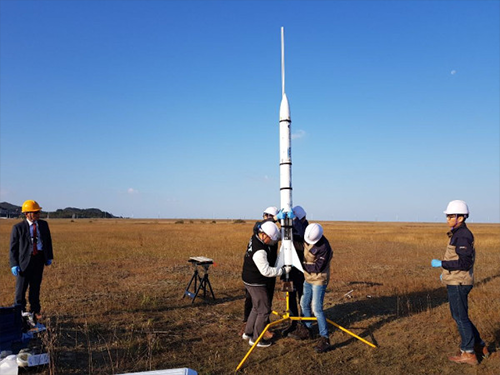 KAIST Launches Woorisae II
Professor Sejin Kwon from the Department of Aerospace Engineering and his team succeeded in launching a science rocket, named ‘Woorisae II’ at Saemanguem reclamation. This rocket was developed in collaboration with the Satellite Technology Research Lab (SaRTec).
The test-firing was conducted at 10:43 am on Sunday October 28, 2018 (35°N 42’ 06” 126°E 33’ 36”, Radius of 0.6NM). This launch was the follow-up to the previous launch that was cancelled due to not gaining approval for using the airspace.
Professor Kwon’s team put a great deal of effort into securing the land for the rocket launch. As a result, they got approval from the Saemangeum Development and Investment Agency for the land and the Ministry of Land, Infrastructure and Transport for the use of the airspace. The Republic of Korea Air Force and United States Air Force also approved the use of the airspace for the launch of the science rocket for research purposes.
Woorisae II is 2.2 meters long with a diameter of 20cm, and weighs 13kg without a payload. The rocket is powered by a hybrid rocket with hydrogen peroxide oxidizer producing 100 kg of force. The Woorisae II sounding rocket was designed to burn for five seconds and then continue inertial flight for 20 seconds. The target altitude of Woorisae II was set at 3,300 feet to comply with the airspace approval.
The team developed the core components, including a hybrid rocket propulsion system, flight computer and parachute recovery system, as well as a ground control station. The flight data was transmitted to the ground station and recorded to onboard computer memory.
When a malfunction occurs during the flight, Woorisae II was designed to terminate the power flight for safety by shutting the propellant valve and deploying the recovery parachute. All the rocket subsystems and components were developed and supplied by domestic startup companies such as INOCOM and NARA SPACE TEHCNOLOGY.
Generally, sounding rockets reach an altitude beyond 30km and are widely used for testing rocket engines and reentry materials as well as for conducting microgravity experiments. Instruments for atmospheric science can also be installed to measure fine dust and high altitude atmosphere. Besides these science and technology purposes, most advanced spacefaring countries have sounding rocket programs to train and educate young people in the field of space science.
Professor Kwon said, “We will plan to launch upgraded rockets on November 4 and December 6 because we already received approval from the related agencies for using this land and airspace. Based on the experiment, we are planning to develop a cost-efficient small launch vehicle that is capable of delivering a cube satellite into Earth’s orbit.”
(Photos of preparing the rocket launch)
2018.10.29 View 10692
KAIST Launches Woorisae II
Professor Sejin Kwon from the Department of Aerospace Engineering and his team succeeded in launching a science rocket, named ‘Woorisae II’ at Saemanguem reclamation. This rocket was developed in collaboration with the Satellite Technology Research Lab (SaRTec).
The test-firing was conducted at 10:43 am on Sunday October 28, 2018 (35°N 42’ 06” 126°E 33’ 36”, Radius of 0.6NM). This launch was the follow-up to the previous launch that was cancelled due to not gaining approval for using the airspace.
Professor Kwon’s team put a great deal of effort into securing the land for the rocket launch. As a result, they got approval from the Saemangeum Development and Investment Agency for the land and the Ministry of Land, Infrastructure and Transport for the use of the airspace. The Republic of Korea Air Force and United States Air Force also approved the use of the airspace for the launch of the science rocket for research purposes.
Woorisae II is 2.2 meters long with a diameter of 20cm, and weighs 13kg without a payload. The rocket is powered by a hybrid rocket with hydrogen peroxide oxidizer producing 100 kg of force. The Woorisae II sounding rocket was designed to burn for five seconds and then continue inertial flight for 20 seconds. The target altitude of Woorisae II was set at 3,300 feet to comply with the airspace approval.
The team developed the core components, including a hybrid rocket propulsion system, flight computer and parachute recovery system, as well as a ground control station. The flight data was transmitted to the ground station and recorded to onboard computer memory.
When a malfunction occurs during the flight, Woorisae II was designed to terminate the power flight for safety by shutting the propellant valve and deploying the recovery parachute. All the rocket subsystems and components were developed and supplied by domestic startup companies such as INOCOM and NARA SPACE TEHCNOLOGY.
Generally, sounding rockets reach an altitude beyond 30km and are widely used for testing rocket engines and reentry materials as well as for conducting microgravity experiments. Instruments for atmospheric science can also be installed to measure fine dust and high altitude atmosphere. Besides these science and technology purposes, most advanced spacefaring countries have sounding rocket programs to train and educate young people in the field of space science.
Professor Kwon said, “We will plan to launch upgraded rockets on November 4 and December 6 because we already received approval from the related agencies for using this land and airspace. Based on the experiment, we are planning to develop a cost-efficient small launch vehicle that is capable of delivering a cube satellite into Earth’s orbit.”
(Photos of preparing the rocket launch)
2018.10.29 View 10692